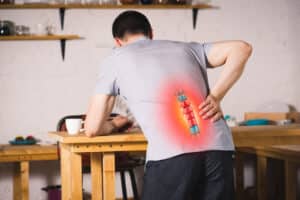
This is often the result of disc herniation. This is the term used when the disc’s inner gel material swells and pushes through the outer membrane. Sometimes a herniated disc comes later after that disc has bulged in some area for a period. Other times, the disc herniation is an instant result, such as in a car crash or when lifting something heavy with incorrect form.
How common are herniated discs?
Every year, about 2% of Americans get a herniated disc. Herniated discs are a leading cause of neck and/or arm, and back and/or leg pain. Discs can herniate anywhere along the spine, but they most often do so in the lower back and neck areas. Disc herniation in the thoracic/central spine are rare.
Who gets herniated discs?
One good thing about passing your 50th birthday is that your spinal discs have hardened to the point where they probably won’t herniate any longer.
Otherwise, people ages 30 to 50 are most likely to get herniated discs. Men are twice as likely as women to herniate a disc. These are other risk factors:
- Sitting for long periods in the same position
- Being overweight
- Lifting heavy objects
- Repetitive bending or twisting motions for work, sports, or hobbies
- Smoking
- Genetics
Causes
Disc herniation is most often the result of a gradual, aging-related wear and tear. This is disc degeneration, and no one is immune to its potential to create disc herniation. As we age, our discs become less flexible and more prone to tearing or rupturing with even a minor strain or twist.
How do you know if you’ve herniated a disc?
Some lucky souls have a herniated disc, and they don’t have any symptoms. That’s because the area where the inner gel is pushing out is not impacting a nearby nerve. But that’s rare. Signs and symptoms of a herniated disc usually affect one side of the body, the area served by the affected nerve. These are typical symptoms:
- Arm or leg pain — If your herniated disc is in your lower back, you’ll typically feel the most pain in your buttocks, thigh, and calf. If the disc is in your neck, you’ll likely have pain in your shoulder and arm.
- Numbness or tingling — Radiating numbness or tingling can occur in the body part served by the affected nerves.
- Weakness — Muscles served by the affected nerves tend to weaken. This can cause you to stumble or make it difficult to lift or hold items. Weakness is a sign of possible nerve damage, so this needs to be addressed immediately by the team at Texas Neurosurgery.
If you have symptoms of a herniated disc, now is the time to set up an appointment with our team at Texas Neurosurgery. Give us a call at (214) 823-2052 to schedule your consultation.

